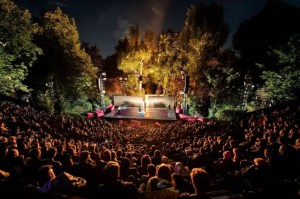Matt Trueman: Theatre's ongoing lack of diversity is inexcusable
Major London theatres have just five BAME associate artists between them – this needs to change

© Helen Murray
Early on, Rufus Norris was given a right grilling by the actor Kobna Holdbrook-Smith, making Jeremy Paxman look like a pushover in the process. One of the things he wanted to know was if there was anyone at the National of black, Asian or minority ethnic (BAME) heritage who had Norris's ear when it came to programming and policy.
Essentially, Holdbrook-Smith was asking about associate artists – and the truth is that at this level of British theatre the lack of diversity is inexcusable.
Most theatres have one artistic director, some have two – and, consequently (though not excusably), very few at that topmost level are of BAME heritage; only Indhu Rubasingham at the Tricycle and Madani Younis at the Bush in London.
However, many of those artistic directors appoint a team of four, five, six – sometimes as many as 12 – associate artists and those selected are overwhelmingly white and male as well. That's a real problem: associates are best placed to present their work at our major theatres and to widen the pool of artists making work in those spaces.
Norris hasn't a single BAME associate on his team at the National. The same is true at the Donmar Warehouse, the Lyric Hammersmith, the Almeida, Royal Court and the Old Vic, where Matthew Warchus appointed a dozen associates last month. Of the Young Vic's 12 associate artists and companies, only Amir Nizar Zuabi is non-white.
In London, the Tricycle is the one theatre with more than one BAME associate, though the Gate's team at least falls in line with the national population.
All in all, London's major theatres have five BAME associate artists between them. Three of those theatres – the Old Vic, the Lyric and the Donmar – only count one woman amongst their associates. Only four – the National, Royal Court, Almeida and the Gate – are at least gender balanced.
Why fixate on one particular level, rather than the overall situation across British theatre? It's a fair question. However, the position of associate artist is an unusual one.
Most associate artists are employed in a part-time, non-exclusive capacity. There are fixed, full-time and in-house associate positions, but the majority are less formal than that. Each theatre is set up slightly differently. The Bush scrapped associate artists outright, the Almeida only has two full-time staff associates, while the RSC has a large pool of associates with strong, historic links to the company, but no formal role or responsibilities. The Lyric has a diverse range of partner organisations.
'A homogeneous team of associates is more likely to result in homogeneous programming'
Usually, associates are employed in an advisory capacity, so a team of associates will meet with an artistic director to discuss future programming and policy. They will read scripts, see shows and make suggestions. They are an artistic director's creative lieutenants: trusted, respected and experienced.
Partly, then, the imbalance has its roots in systemic problems. Associates will likely have achieved a certain level of success already and if the industry as a whole disadvantages BAME artists, fewer will get to that level.
However, associates are appointed directly, usually without the need for an application process. It's a case of an AD deciding on the artists that he or she really believes in and signing them up for his or her theatre. On account of this informal process, they may well fall outside the usual equality and opportunity monitoring procedures.
We all have our biases and blindspots, which is not to excuse them, but a homogeneous team of associates is more likely to result in homogeneous programming. Any artistic director concerned about diversity – not just with regards employment figures, but in terms of the stories told on their stages – needs a diverse pool of associates. Not only would those artists themselves have a regular platform for their work, they could help to significantly widen the pool of artists and subjects under consideration in the programming process.
Associate artists inevitably have the easiest 'in' at a given venue. They work closely with the artistic director, offering advice and discussing options. They are privy to scripts under consideration and programmes coming together, a massive advantage when pitching or bagsying projects. They also have easy access to the facilities at a theatre. What's more, they are paid a regular fee, immediately eases the pressure on having to take on other work. It is a privileged position and, as with so many such opportunities, the majority are with those that come from a position of privilege.
The thing is, this particular issue is very easily solvable – even if it doesn't immediately sovle the overall lack of diversity. These are pro-rata (in some cases unpaid) positions and there's no limit on the number of associates a theatre might have on its staff. Nor is there any need to circumvent employment or make staff redundant to level the situation out. It's simply a matter of making an appointment or two. We could have proportional representation at associate level by the end of the summer. There's really no excuse.












